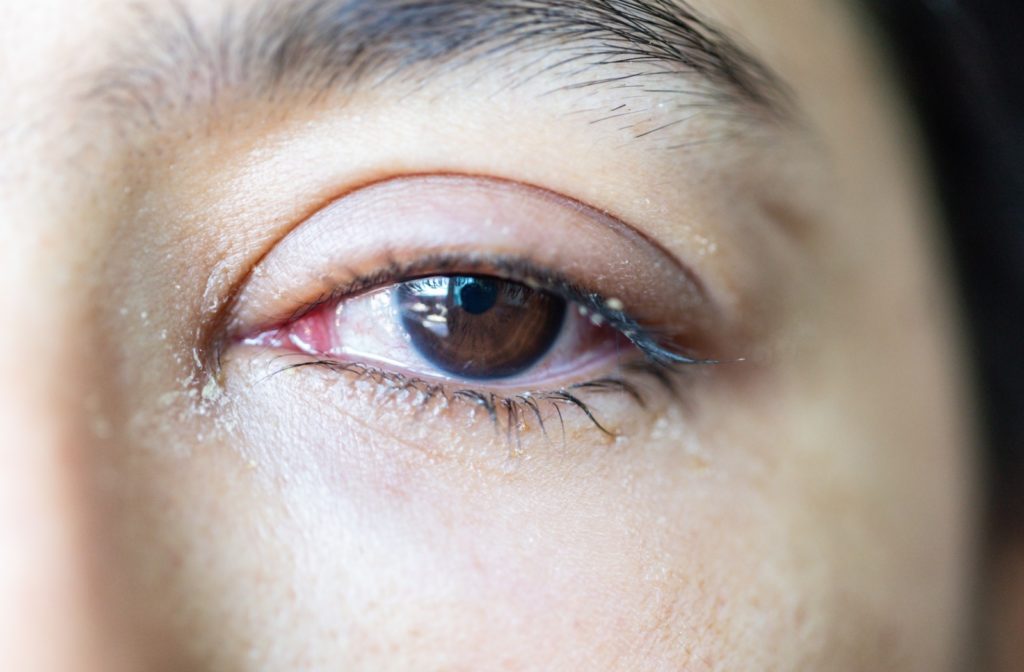Astigmatism is a common condition that affects how the eye focuses light, often leading to blurry or distorted vision. While watery eyes are not typically listed as a direct symptom of astigmatism, certain factors linked to the condition can indirectly contribute to this issue. If you’re experiencing excessive tear production, understanding how astigmatism and other conditions might be related to watery eyes can provide clarity and help guide your next steps.
At Southwood Eyecare, we believe your eyes deserve exceptional care. Our comprehensive eye exams are designed to not only assess your vision but also safeguard your overall eye health.
What Is Astigmatism?
Astigmatism occurs due to an irregular shape in the cornea (the clear, dome-shaped surface of the eye) or the lens inside the eye. Instead of being perfectly spherical, it is shaped more like a football. This irregular curvature prevents light from focusing evenly on the retina—the light-sensitive layer at the back of the eye—causing blurred or distorted vision.
Some of the more common symptoms of astigmatism include:
- Blurry or distorted vision at various distances.
- Eye strain or discomfort, especially after activities requiring focus, like reading or using screens.
- Headaches stemming from visual exertion.
- Squinting to achieve better clarity.
While watery eyes are not a primary symptom of astigmatism, it’s worth examining whether related factors might play a role in cases where tearing becomes troublesome.
Understanding Watery Eyes
Watery eyes, technically termed epiphora, happen when the eyes either produce too many tears or fail to drain them effectively. Your tears are essential for keeping your eyes healthy, as they maintain moisture and protect the eyes from irritants. However, imbalances in the tear production process can lead to excess tearing, causing discomfort in daily life.
Here are some common causes of watery eyes:
Dry eye syndrome: It may seem counterintuitive, but dry eyes are one of the leading causes of excessive tearing. When the eyes feel irritated due to dryness, they may produce an overflow of reflex tears that lack the proper composition to coat and soothe the eye effectively.
Irritation and environmental factors: External elements like cold wind, dust, smoke, or bright light can irritate the surface of the eye, prompting a tear response.
Blocked tear ducts: Tears normally drain through small openings in the corners of your eyes. If these ducts become clogged, tears can accumulate, leading to constant watering.
Allergies: Seasonal or environmental allergies can irritate the eyes, causing them to water excessively as part of the body’s immune response.

Underlying medical conditions: Issues like inflamed eyelids (blepharitis), conjunctivitis, or other ocular surface conditions can also disrupt the tear system and result in watery eyes.
Can Astigmatism Indirectly Contribute to Watery Eyes?
Although astigmatism itself doesn’t directly cause watery eyes, it can influence other factors that lead to tear overproduction. Here are several ways astigmatism may indirectly contribute to excessive tearing:
Eye Strain & Irritation
Uncorrected astigmatism often leads to overexertion of the eyes. Whether you’re reading, working on a computer, or focusing on distant objects, your eyes have to work harder to process a clear image. This strain can cause irritation, triggering the body’s natural reflex to produce more tears as a protective response.
Dry Eyes
People with astigmatism frequently engage in activities that may exacerbate dry eye symptoms, such as extended screen use or prolonged focus on small text. Dryness causes a breakdown of the tear film, leading to discomfort; the eyes may then overcompensate by producing watery but ineffective “reflex tears.”
Uncorrected Vision
When astigmatism goes untreated, the mismatch between the eye’s focusing ability and the visual demand can lead to continued discomfort. This may increase the likelihood of reflex tearing, especially when coupled with activities or environments that strain the eye.
While the relationship between astigmatism and watery eyes is more circumstantial than direct, addressing astigmatism through proper vision correction can often alleviate associated discomfort and reduce the likelihood of secondary problems like eye strain and tear overproduction.
Other Potential Causes to Rule Out
If you’re dealing with persistent watery eyes, it’s essential to explore other possible causes in addition to astigmatism. Conditions like the following could be contributing to your symptoms:
- Blepharitis: Chronic eyelid inflammation can compromise the production of the tear film’s oily layer, leading to irritation and watering.
- Conjunctivitis: Eye infections or allergic reactions can cause redness, itching, and watery eyes.
When Should You See a Professional?
If watery eyes are frequent, bothersome, or accompanied by other symptoms such as redness, pain, or vision changes, it’s essential to see an eye care professional. Proper diagnosis ensures that the underlying cause is identified and treated effectively.
An optometrist or ophthalmologist can perform a detailed eye examination to assess your overall eye health, visual needs, and tear production system. For those with astigmatism, they can recommend appropriate corrective options like glasses, contact lenses, or even specialized treatments to improve visual comfort and prevent complications.
The Bottom Line
Though astigmatism itself doesn’t directly lead to watery eyes, its impact on eye strain and dryness can sometimes contribute to tear overproduction. If you experience persistent tearing, it’s important to consider all potential causes and seek guidance from our eye care professionals at Southwood Eyecare.
Taking the time to address vision issues like astigmatism, as well as investigating other contributing factors, can greatly improve your eye comfort. For those in Calgary looking to better understand their eye health, consider visiting us at Southwood Eyecare, where our comprehensive care can help you find the solution that fits your needs.




